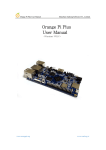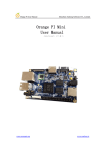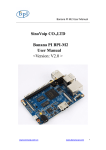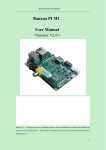Download Orange Pi PC User Manual
Transcript
Orange Pi PC User Manual Shenzhen Xunlong Software CO., Limited Orange Pi PC User Manual < V0.9.1 > www.orangepi.org www.xunlong.tv Orange Pi PC User Manual Shenzhen Xunlong Software CO., Limited What’s Orange Pi PC? It’s an open-source single-board computer. It can run Android 4.4, Ubuntu, Debian, Rasberry Pi Image, as well as the Banana Pi Image. It uses the AllWinner H3 SoC, and has 1GB DDR3 SDRAM. What can I do with Orange Pi PC? Build… A computer A wireless server Games Music and sounds HD video A speaker Android Scratch Have much more functions, because Orange Pi PC is open source. Whom is it for? Orange Pi PC is for anyone who wants to create with technology – not just consuming. It's a simple, fun, useful tool and you can use it to take control of the world around you. www.orangepi.org www.xunlong.tv Orange Pi PC User Manual Shenzhen Xunlong Software CO., Limited Hardware Specification CPU H3 Quad-core Cortex-A7 H.265/HEVC 4K GPU Mali400MP2 GPU @600MHz, Supports OpenGL ES 2.0 Memory (SDRAM) 1GB DDR3 (share with GPU) Onboard Storage TF card (Max. 64GB) / MMC card slot Onboard Network 10/100M Ethernet RJ45 A CSI input connector Camera: Supports 8-bit YUV422 CMOS sensor interface Video Input Supports CCIR656 protocol for NTSC and PAL Supports SM pixel camera sensor Supports video capture solution up to 1080p@30fps Audio Input MIC Supports HDMI output with HDCP Supports HDMI CEC Video Output Supports HDMI 30 function Integrates CVBS Supports simultaneous output of HDMI and CVBS Audio Output HDMI and 3.5mm Jack Power Source DC input, USB OTG input don’t supply power USB 2.0 Port Three USB 2.0 HOST, one USB 2.0 OTG Button Power Button(SW4) Low-level peripherals 40 Pins Header, compatible with Raspberry Pi B+ www.orangepi.org www.xunlong.tv Orange Pi PC User Manual Shenzhen Xunlong Software CO., Limited GPIO(1x3) pin UART, ground. LED Power led & Status led Key IR, POWER Supported OS Android, Ubuntu, Debian, Rasberry Pi Image Cosmetic Specification Product size 85mm × 55mm Weight 38g Orange Pi™ is a trademark of the Shenzhen Xunlong Software CO., Limited Hardware Top view Bottom view www.orangepi.org www.xunlong.tv Orange Pi PC User Manual Shenzhen Xunlong Software CO., Limited Interface instructions www.orangepi.org www.xunlong.tv Orange Pi PC User Manual Shenzhen Xunlong Software CO., Limited Using method You can use your Orange Pi PC quickly if you follow the following steps, it takes only three steps to boot your Orange Pi PC. Step 1 Necessary Accessories www.orangepi.org www.xunlong.tv Orange Pi PC User Manual Shenzhen Xunlong Software CO., Limited Following accessories are required if it is the first time you use Orange Pi PC. No. Items Requirements and Instructions 1 TF card • • 4Gb min.; class 4 (the class indicates how fast the card is). Branded TF cards which are much more reliable are the good choice. 2a HDMI to HDMI cable or HDMI to DVI cable • • HDMI to HDMI cable is used to connect HD TV or HD monitor; HDMI to DVI cable is used to connect DVI monitor. 2b AV video cable 3 Keyboard and mouse 4 Ethernet cable/USB WiFi(Optional) 5 A standard AV video cable can be used to connect stimulated monitor if a HDMI monitor is unavailable. Any keyboard and mouse with USB port is applicable; Keyboard and mouse are high-power, so a USB concentrator is required. Network is optional, It makes more convenient to mount and upgrade software in your Orange Pi PC. DC power adapter 5V,2V min. high qualified power adaptor, OTG can not used a power supply. 6 Audio cable (Optional) • You can select an audio cable with 3.5mm jack to feel stereo audio. www.orangepi.org www.xunlong.tv Orange Pi PC User Manual HDMI to HDMI cable Shenzhen Xunlong Software CO., Limited HDMI to DVI cable TF card AV video cable DC power adapter Step 2 Prepare TF card for Orange Pi PC Operation System (OS) should be installed in a TF card before using an Orange Pi PC. In the following we will tell you how to program an OS image file into a TF card Under Windows and Linux OS. How to Program an OS into a TF card? Windows: 1. Insert your TF card into your computer. The capacity of a TF card should be larger than OS image, generally 4GB min. 2. Format the TF card. i. Download a format tool of TF card, such as TF Formatter. You can download it from the following link, https://www.sdcard.org/downloads/formatter_4/eula_windows/. ii. Unzip the downloaded file and run the setup.exe to install the tool on your machine. iii. In the "Options" menu, set "FORMAT TYPE" option to "QUICK”, and “FORMAT SIZE ADJUSTMENT" option should be "ON". www.orangepi.org www.xunlong.tv Orange Pi PC User Manual Shenzhen Xunlong Software CO., Limited iv. Make sure the inserted TF card codes are in accordance with the chosen codes. v. Click the “Format” button. 3. Download the OS image from the website, the Website is http://www.orangepi.org/downloadresour the ces/ 4. Unzip the downloaded file to get the OS image (except android os image). 5. Program the image file into the TF card. i. Download a tool,such as Win32 Diskimager, the website is http://sourceforge.net/projects/win32diskimager/files/Archive/ ii. Open the unzipped image file. iii. Click “Write” button. Please wait a moment until the image is written. IV. Click “Exit” button after image is written. Linux: 1. Insert your TF card into your computer. The capacity of TF should be larger than the OS image, generally 4GB min.. www.orangepi.org www.xunlong.tv Orange Pi PC User Manual Shenzhen Xunlong Software CO., Limited 2. Format the TF card. i. Run fdisk –l /dev/sdx command to confirm the TF card code. ii. Run umount /dev/sdxx to un-mount all the partitions of the TF card. iii. Run sudo fdisk /dev/sdx command to configure TF card. Use o command to delete all partitions of TF card and use n command to add a new partition. Then use w command to save and exit. iv. Run sudo mkfs.vfat /dev/sdx1 command to format the new generated partition of TF card as FAT32. (x should be replaced according to your TF card code) You can also skip this step under Linux, because dd command under Linux will format TF card automatically. 3. Download the OS image from the Website http://www.orangepi.org/downloadresources/ 4. Unzip the downloaded file (except android os image). 5. Write the image file into the TF card. i. Run fdisk –l /dev/sdx command to confirm the TF card code. ii. Please make sure the hash key of image file is in accordance with the downloaded one (optional). sha1sum [path]/[imagename] A series of numbers will be output and it is the same as the “SHA-1” on the downloaded image page. iii. Run umount /dev/sdxx to un-mount all the partitions of the TF card. iv. Run sudo dd bs=4M if=[path]/[imagename] of=/dev/sdx command to write image file to TF card. Please wait a moment until the image written. If 4M is not applicable, please use 1M instead, although it will take much more time.You can use sudo pkill –USR1 –n –x dd command to check progress. How to write an Android OS image into your TF card? It is impossible for Android image file to be written into TF card by using dd command under Linux or by using Win32 Diskimager under Windows. PhoenixCard is applicable. (Note : If your laptop card slot cannot burn the TF card, you can use the TF card reader. ) 1. Download the Android OS image and PhoenixCard. Download PhoenixCard from https://drive.google.com/file/d/0B_VynIqhAcB7NTg2UkRDdHRWX2s/edit?usp=sh aring www.orangepi.org www.xunlong.tv Orange Pi PC User Manual Shenzhen Xunlong Software CO., Limited Download Android OS image from http://www.orangepi.org/downloadresources/ 2. Format the TF card 3. Please make sure the inserted TF card is in accordance with the chosen, click “restore” button for TF card format. www.orangepi.org www.xunlong.tv Orange Pi PC User Manual Shenzhen Xunlong Software CO., Limited Successfully to format the TF card to normal, click the “OK” button. 4. Then burn the Android OS image to your TF card. Please pay attention to the following with red marks. www.orangepi.org www.xunlong.tv Orange Pi PC User Manual Shenzhen Xunlong Software CO., Limited Click the “Burn” button. Burn Android OS image to TF card successfully. Click “Exit”. www.orangepi.org www.xunlong.tv Orange Pi PC User Manual Shenzhen Xunlong Software CO., Limited Step3: Boot your Orange Pi PC According to diagram below, you can easily boot your Orange Pi PC. Hardware connection sketch map www.orangepi.org www.xunlong.tv Orange Pi PC User Manual Shenzhen Xunlong Software CO., Limited Hardware real objects picture-top view www.orangepi.org www.xunlong.tv Orange Pi PC User Manual Shenzhen Xunlong Software CO., Limited Hardware real objects picture-bottom view 1. Insert the TF card with written-image into the TF card slot on the left edge of the board. 2. In the middle of lower edge of the board is the HDMI Type A (Full sized) port which is used to your Orange Pi PC, HDMI TV or monitor. If you don’t have a monitor with HDMI or DVI port, you can output audio and video to stimulated TV or monitor with the help of Yellow AV port in the middle of the upper part of the board and audio port on the right side of the board 3. Plug the USB port of the keyboard and mouse into the USB port on the right edge of the board. 4. Ethernet connector is in the middle of the three USB ports, you can link your Orange Pi PC with cable network www.orangepi.org www.xunlong.tv Orange Pi PC User Manual Shenzhen Xunlong Software CO., Limited 5. On the right side of the Lower part of the board is the power input port, 5V 2A min. power adapter is applicable. Please do not use low-powered GSM cellphone charger, even though it is marked”5V 2A”. Note : Micro USB OTG cannot be used as a power supply, which will freeze the board. Only a DC power port can be used to supply power. If everything in the above-mentioned steps goes very well, the Orange PC will booted in a few minutes. The screen will display the OS GUI(Graphical User Interface). The first boot of a new OS will take a long time. So be patient! Subsequent boots will be much quicker. Step 4 Turn off your Orange Pi PC You can turn off your Orange Pi PC safely with the help of “OFF” button on the screen. Also you can input command sudo halt or sudo shutdown –h. in the shell to turn off the system. In this case, your Orange Pi PC will be turned off safely, I you just turn off the power supply, it will damage the system of TF card. You’d better press the Power button for 5 seconds at least to cut off the power. . If everything goes very well, you can use orange pi pc now. GPIO specification Orange Pi PC 40-pin GPIO A 40-pin GPIO interface on the Orange Pi PC is the same as Model A and Model B of Raspberry Pi. The picture below is GPIO pin define of Orange Pi PC. Orange_Pi-PC(H3) CON3-P01 CON3-P02 CON3-P03 www.orangepi.org VCC-3V3 VCC-5V TWI0-SDA PA12 www.xunlong.tv Orange Pi PC User Manual CON3-P04 CON3-P05 CON3-P06 CON3-P07 CON3-P08 CON3-P09 CON3-P10 CON3-P11 CON3-P12 CON3-P13 CON3-P14 CON3-P15 CON3-P16 CON3-P17 CON3-P18 CON3-P19 CON3-P20 CON3-P21 CON3-P22 CON3-P23 CON3-P24 CON3-P25 CON3-P26 CON3-P27 CON3-P28 CON3-P29 CON3-P30 CON3-P31 CON3-P32 CON3-P33 CON3-P34 CON3-P35 CON3-P36 CON3-P37 CON3-P38 CON3-P39 CON3-P40 Shenzhen Xunlong Software CO., Limited VCC-5V TWI0-SCK GND PWM1 UART3_TX GND UART3_RX UART2_RX PD14 UART2_TX GND UART2_CTS PC4 VCC-3V3 CAN_RX SPI0_MOSI GND SPI0_MISO UART2_RTS SPI0_CLK SPI0_CS0 GND PA21 TWI1-SDA TWI1-SCK PA7 GND PA8 UART1_RTS PA9 GND PA10 UART1_CTS PA20 UART1_TX GND UART1_RX PA11 PA6 PA13 PA14 PA1 PD14 PA2 PA3 PC4 PC7 PC0 PC1 PA2 PC2 PC3 PA21 PA19 PA18 PA7 PA8 PG8 PA9 PA10 PG9 PA20 PG6 PG7 Specification of CSI Camera Connector CSI Camera Connector The CSI Camera Connector is a 24-pin FPC connector which can connect external camera module with proper signal pin mappings. The pin of CIS connector can be defined as follows. The connector marked with “CON 1” on the Orange Pi PC is camera connector. www.orangepi.org www.xunlong.tv Orange Pi PC User Manual Shenzhen Xunlong Software CO., Limited OrangePi PC-CSI CON1-P01 CON1-P02 CON1-P03 CON1-P04 CON1-P05 CON1-P06 CON1-P07 CON1-P08 CON1-P09 CON1-P10 CON1-P11 CON1-P12 CON1-P13 CON1-P14 CON1-P15 CON1-P16 CON1-P17 CON1-P18 CON1-P19 CON1-P20 CON1-P21 CON1-P22 CON1-P23 CON1-P24 www.orangepi.org NC GND TWI2-SDA VCC-CSI TWI2-SCK CSI-RESET# CSI-VSYNC CSI-STBY-EN CSI-HSYNC VDD1V8-CSI VCC-CSI CSI-D7 CSI-MCLK CSI-D6 GND CSI-D5 CSI-PCLK CSI-D4 CSI-D0 CSI-D3 CSI-D1 CSI-D2 GND AFVCC-CSI PE13 PE12 PE15 PE3 PE15 PE2 PE11 PE1 PE10 PE9 PE0 PE8 PE4 PE7 PE5 PE6 www.xunlong.tv































